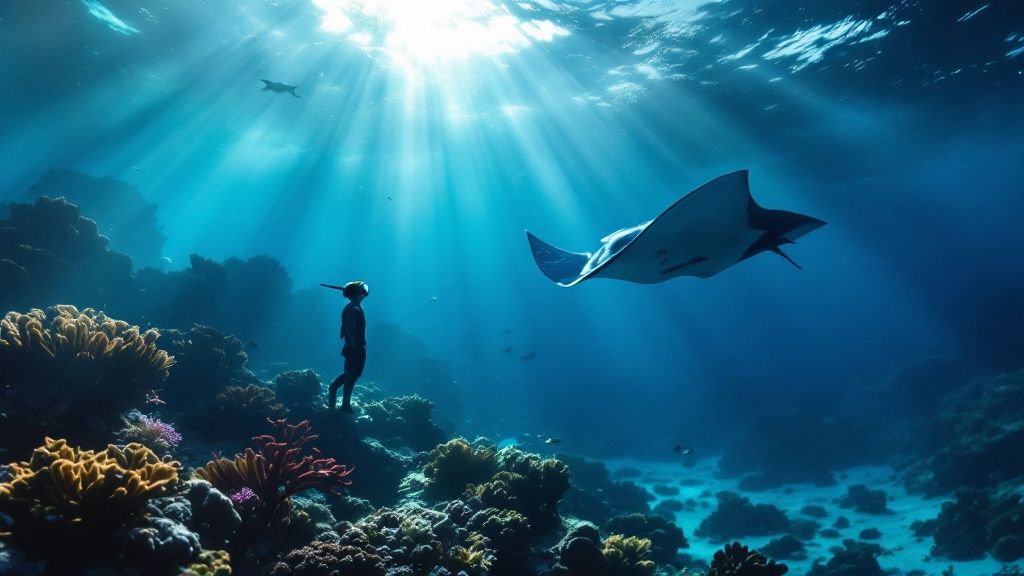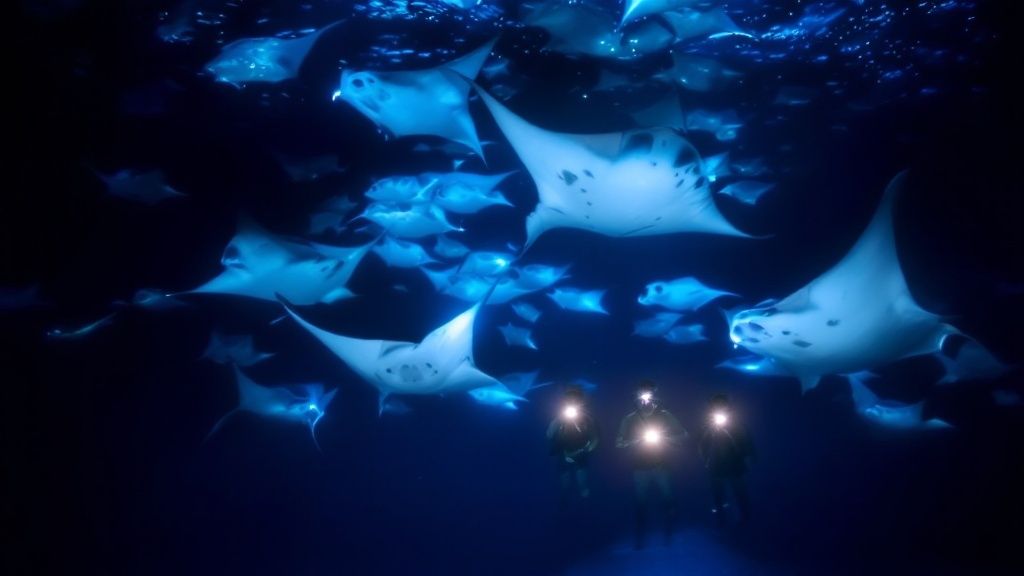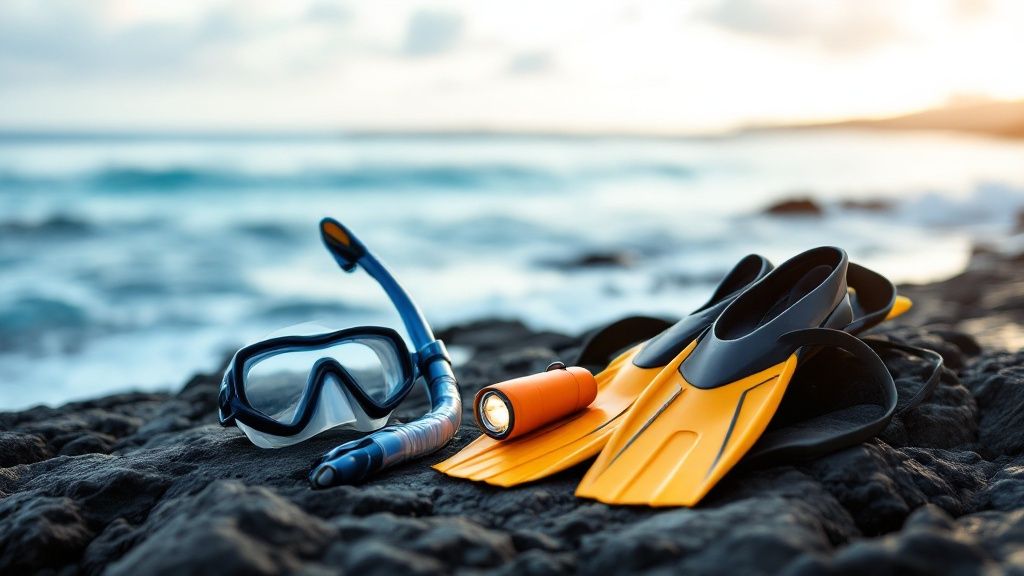Manta Ray Snorkel Kona | Unforgettable Hawaii Marine Adventure
- Byron
- May 13
- 11 min read
Why Manta Ray Snorkel Kona Transforms Ocean Enthusiasts

Swimming with manta rays is often described as a life-altering experience. Kona, Hawaii, provides one of the best places in the world to do it. The Kona manta ray snorkel offers a truly unique experience due to a special combination of factors. The warm, clear waters offer amazing visibility. The predictable feeding habits of the mantas practically guarantee a sighting.
This means you aren't just hoping to glimpse these gentle giants; you’re almost certain to encounter them up close.
The experience is made even more special by the magic of nighttime snorkeling. Imagine yourself floating on the ocean’s surface, peering into the illuminated depths. Massive manta rays, some with wingspans reaching 16 feet, glide effortlessly below. This isn't just observing wildlife; it's a deeply immersive, personal connection.
The darkness adds to the wonder, creating a feeling of awe and connection with these majestic creatures. This feeling stays with you long after you leave the water. Many first-time snorkelers describe feelings of peace, wonder, and even a spiritual connection.
The Impact of Manta Ray Tourism
Manta ray snorkeling in Kona isn't just a passing fad; it's woven into the local culture and economy. Roughly 80,000 people participate in manta ray snorkeling each year, making it one of Kona’s top attractions. The unique viewing opportunities are a big draw. Popular spots include Manta Village, a shallow area with a sandy bottom perfect for manta feeding. Another favored location is Garden Eel Cove, which sometimes offers the added bonus of observing garden eels. Learn more about the impact of manta ray tourism: Manta Ray Snorkeling Kona: Unforgettable Encounters.
Want a deeper understanding of what makes this experience so special? Check out this expert guide: Manta Ray Snorkel Kona Hawaii: The Ultimate Experience Guide. These graceful creatures aren’t just a spectacle; they are a vital part of the marine ecosystem. Marine biologists see these interactions as essential for building appreciation and understanding of these often misunderstood animals.
Experiencing the manta rays firsthand motivates many visitors to learn more about ocean conservation. This contributes to the protection of these magnificent animals. A manta ray snorkel Kona trip is not only personally enriching; it also benefits the marine environment.
Prime Locations for Extraordinary Manta Ray Encounters
Kona, Hawaii, offers a variety of incredible locations known for their frequent manta ray sightings. Each spot presents a unique snorkeling experience shaped by water conditions, visibility, and the underwater landscape. Selecting the right location can significantly enhance your manta ray snorkel Kona adventure.
Manta Village (Keauhou Bay): A Manta Ray Hotspot
Keauhou Bay, affectionately known as Manta Village, stands out as perhaps the most famous manta ray viewing site. The shallow, sandy bottom of the bay provides an ideal feeding ground, drawing mantas in impressive numbers. The bay's distinct topography also plays a vital role. Its relatively enclosed nature helps concentrate plankton, the manta rays' primary food source, establishing it as a consistently reliable location for close encounters.
Manta Heaven (Garden Eel Cove): A Symphony of Marine Life
Another popular destination is Garden Eel Cove, also known as Manta Heaven. This site occasionally offers a double spectacle: the opportunity to witness both manta rays and garden eels. The cove's diverse ecosystem cultivates a rich feeding ground, attracting not only mantas but also a wide array of other marine life. This vibrant environment creates a truly immersive and unforgettable experience for snorkelers.
This infographic illustrates the average manta ray sighting rates at three well-known Kona snorkeling spots: Kailua Bay, Lapakahi Rocks, and Keauhou Bay. As the infographic indicates, all three locations boast impressive sighting rates: Kailua Bay at 95%, Lapakahi Rocks at 90%, and Keauhou Bay at 85%. These remarkable statistics highlight the consistent opportunities for manta ray encounters in Kona, solidifying its reputation as a premier destination for this unique activity. The Kona Coast, especially around Manta Village and Manta Heaven, has been the focus of substantial manta ray research. From 2009 to 2014, scientists tracked individual mantas, collecting essential data on their health and movement. This research has improved understanding of manta ray behavior and prediction of their presence. For a deeper dive into manta ray statistics, visit Manta Ray Advocates.
To help you choose the perfect snorkeling spot, we've compiled a comparison of Kona's top manta ray viewing locations:
Top Manta Ray Snorkeling Locations in Kona
Location | Best Time to Visit | Average Depth | Typical Visibility | Chance of Sightings | Special Features |
|---|---|---|---|---|---|
Keauhou Bay (Manta Village) | Night | 10-20 feet | 30-50 feet | 85% | Shallow, sandy bottom; enclosed bay concentrates plankton |
Garden Eel Cove (Manta Heaven) | Night | 15-25 feet | 40-60 feet | 75% | Diverse ecosystem; possibility of seeing garden eels |
Kailua Bay | Day/Night | 20-30 feet | 50-70 feet | 95% | Open bay; variety of marine life |
This table provides a quick overview of the key features of each location, helping you make an informed decision based on your experience level and preferences. Remember to consider factors like time of day and water conditions when planning your excursion.
Exploring Beyond the Popular Spots
While Manta Village and Manta Heaven are renowned, Kona offers other, less-traveled locations. These hidden gems can provide a more intimate experience with the manta rays. Furthermore, varying depths and visibility across different locations make some better suited for beginners while others cater to more experienced snorkelers. For more information about navigating our blog and resources, see our sitemap: Read also: Navigating Our Blog. Ultimately, understanding the specific characteristics of each site allows you to personalize your manta ray snorkel Kona experience to your skill level and desired interaction.
The Complete Manta Ray Snorkel Kona Experience Decoded

A manta ray snorkel Kona adventure is more than just a quick swim in the ocean; it’s a well-planned experience. From boarding the boat to the incredible encounter with the manta rays, and finally the return trip, every part of the journey adds to the overall magic. This guide will break down each step so you know exactly what awaits you.
From Shore to Ocean: Setting the Stage
The adventure begins with a boat ride to a special manta ray viewing area. During the trip, guides brief you on safety procedures and provide fascinating information about manta ray behavior and biology. This educational element enhances the experience. You might be interested in learning more about manta ray adventures. For example, you'll learn about the "manta ray campfire" formation, a unique feeding behavior. Mantas circle together with their mouths open, creating a breathtaking display. This formation also provides snorkelers with optimal viewing angles.
The Science of the Plankton Vortex
Once at the viewing site, special underwater lights are placed in the water. These lights attract plankton, the manta rays' main food source. This creates a swirling vortex, drawing the mantas in for a closer look. This clever method provides a reliable way to observe these gentle giants feeding naturally. One of the most exciting aspects of manta ray snorkeling in Kona is how often you’re likely to see them.
Manta Ray Sightings: A Remarkable Statistic
According to reports, manta rays are spotted roughly 80 to 90% of the time, no matter what time of year it is. This reliability makes Kona a top location for manta ray enthusiasts. These frequent sightings are thanks to the area’s unique marine environment, which is perfect for feeding and interaction. Jack's Diving Locker mentions spotting mantas approximately 85-90% of the time, showcasing the area’s appeal. For more detailed sighting statistics, check out the Jack's Diving Locker Manta Ray Report.
Addressing Common Concerns
Many first-time snorkelers wonder about seasickness, water temperature, and how strong a swimmer they need to be. Most tours offer seasickness remedies, and the water is typically a comfortable temperature. While you don't need to be an Olympic swimmer, basic comfort in the water is recommended. Guides are available to provide assistance, ensuring everyone’s safety and enjoyment. This attention to detail helps enhance everyone's experience.
The Emotional Journey: From Nervousness to Wonder
The emotional experience of a manta ray snorkel is quite a journey. It’s normal to feel a bit nervous, especially for first-time snorkelers. However, this quickly shifts to awe as the first manta ray comes into view. Guides create a supportive and encouraging environment. They offer insights, answer questions, and help snorkelers relax. This ensures that even those who start out a little apprehensive can truly appreciate this unique marine encounter.
Selecting Your Perfect Manta Ray Snorkel Kona Adventure
Planning a manta ray snorkel tour in Kona? Choosing the right tour operator can transform your trip from simply good to absolutely unforgettable. While glossy brochures and captivating websites are appealing, there's more to consider when selecting the perfect Kona adventure. Key factors distinguish truly exceptional tour operators, affecting not just your enjoyment, but also the well-being of the majestic manta rays.
Prioritizing Safety and Responsibility
Look for tour operators that prioritize your safety and the health of the marine environment. Lifeguard training for all guides demonstrates a strong commitment to guest safety. Responsible operators also actively engage in marine conservation efforts, educating guests about the fragile ecosystem and following best practices to minimize disturbance to the manta rays and their habitat.
Group Size Matters
A smaller snorkel group can significantly enhance your manta ray encounter. Smaller groups, typically around 6-10 people, allow for more personalized attention from the guides. This creates a more intimate and enriching experience, focusing on the natural beauty of the manta rays. Larger, crowded groups can feel chaotic and detract from the tranquility of the experience.
Boat Design and Equipment
Consider the boat design and the quality of the provided equipment. A comfortable boat with easy water access makes your trip more enjoyable. High-quality snorkel gear, including well-fitting masks and fins, is crucial for a pleasant and safe snorkeling experience. Some operators even offer wetsuits or flotation devices for added comfort and confidence in the water. For more insights, you might find this helpful: Learning more about selecting a tour.
Asking the Right Questions
Before booking, don't hesitate to ask questions. Inquire about group size limits, guide experience, safety protocols, and environmental practices. A reputable operator will be transparent and happy to address your concerns. This allows you to make an informed choice aligned with your values.
Key Considerations When Choosing a Tour
To simplify the decision-making process, the table below summarizes key factors to consider when choosing your manta ray snorkel tour. It provides valuable insights into what to look for and potential red flags to avoid, helping you select the best tour for your needs.
Manta Ray Snorkel Tour Comparison Guide
Consideration | What to Look For | Red Flags to Avoid | Why It Matters |
|---|---|---|---|
Group Size | Small groups (6-10 people) | Large groups (20+ people) | Smaller groups offer more personalized attention and minimize disturbance to the mantas. |
Guide Experience | Certified lifeguards; extensive knowledge of manta rays and local marine life | Inexperienced guides; lack of safety certifications | Experienced guides ensure your safety and enhance your understanding of the manta rays. |
Environmental Practices | Commitment to sustainable tourism; adherence to responsible viewing guidelines | Lack of environmental awareness; disregard for manta ray welfare | Responsible practices protect the manta rays and their habitat. |
Equipment Quality | Well-maintained snorkel gear; proper fit and comfort | Worn-out equipment; ill-fitting masks and fins | High-quality gear ensures a comfortable and enjoyable snorkeling experience. |
Boat Design | Easy water access; comfortable seating; ample space | Cramped or unstable boats; difficult entry/exit | A comfortable boat makes the overall experience more pleasant. |
This comparison guide highlights the important aspects of selecting a responsible and enjoyable tour. Choosing wisely ensures a memorable experience for you while contributing to the protection of these incredible creatures.
By considering these factors and asking the right questions, you’re setting the stage for a truly remarkable manta ray snorkel adventure in Kona. This not only maximizes your personal enjoyment, but also contributes to the long-term preservation of these magnificent animals.
Capturing Magical Moments: Manta Ray Photography Mastery

Turning a breathtaking manta ray snorkel Kona adventure into cherished memories requires some photographic skill. This guide explores techniques for capturing incredible images of these gentle giants, regardless of whether you’re using a smartphone in a waterproof case or a professional underwater camera system. Successfully photographing these graceful creatures involves understanding your equipment and the unique underwater environment. You can learn more about these incredible excursions at Manta Ray Night Snorkel Hawaii.
Mastering Camera Settings for Low-Light Conditions
Nighttime manta ray encounters offer distinct photographic challenges. The low light demands careful adjustment of your camera settings. Increasing your ISO allows your camera to gather more light, but it can also create noise, or graininess. Finding the right balance between ISO and shutter speed is key for crisp, well-exposed shots.
A fast shutter speed is vital for freezing the movement of these graceful animals. Manta rays are surprisingly quick, and a slow shutter speed will often result in blurry pictures. Begin with a shutter speed of at least 1/250th of a second and adjust based on the manta's activity and the available light.
Positioning and Respecting Wildlife
Capturing stunning photos is thrilling, but remember to respect the manta rays and their habitat. Maintain a safe distance and avoid any contact or pursuit. This protects their well-being and allows you to observe their natural behavior.
For the best shots, try to anticipate the manta ray’s movements. Position yourself a little ahead of its path, allowing it to swim toward you. This creates dynamic images that showcase their grace and power.
Composition Techniques for Compelling Images
Creating visually appealing photos involves more than just the correct settings. Consider compositional principles, like the rule of thirds, to create balanced and engaging images. Visualize dividing your frame into nine equal sections with two horizontal and two vertical lines. Positioning your subject at the intersection of these lines produces a more visually dynamic image.
Pay attention to the background. A cluttered backdrop can detract from the manta ray's beauty. Look for a clean setting, such as open water or the sandy seabed, to highlight your subject.
Post-Processing for Enhanced Detail
Post-processing can significantly improve your underwater photographs. Adjusting brightness, contrast, and sharpness can bring out subtle details. However, strive to maintain the scene's authenticity. Avoid excessive editing, which can result in unnatural-looking photos.
By blending technical skills with respect for the environment and artistic vision, you can transform your manta ray snorkel Kona experience into a collection of striking images. These photos will be lasting mementos of your incredible encounter with these magnificent creatures.
Protecting the Magic: Sustainable Manta Ray Tourism
The thrill of snorkeling with manta rays in Kona is an unforgettable experience. But with this incredible opportunity comes a responsibility to protect these gentle giants and their fragile environment. Sustainable tourism ensures that future generations can also witness the magic of these graceful creatures.
Understanding Manta Ray Research and Conservation
Researchers in Kona are dedicated to studying manta rays, using their unique spot patterns like fingerprints to identify and track individuals. This research provides valuable insights into their population health, migration routes, and social interactions. This data is essential for developing effective conservation strategies. For instance, knowing their migratory paths helps pinpoint crucial habitats in need of protection. Tracking population size helps assess the impact of human activities and environmental shifts.
Threats to Manta Rays: Global and Local
Manta rays face numerous threats around the world, including fishing pressure (both targeted fishing and accidental bycatch) and the effects of climate change. On a local level, habitat degradation and disturbances from irresponsible tourism also present significant risks. For photographers looking to share their breathtaking manta ray images, understanding online art marketing can be beneficial. All of these threats highlight the urgent need for sustainable tourism practices that prioritize the well-being of these vulnerable animals.
Responsible Tourism: A Force for Good
Fortunately, responsible manta ray tourism can actively contribute to conservation work. Tourism revenue can be directly invested in research and protection programs. By educating visitors about manta rays and the importance of conservation, tourism can foster a sense of responsibility and promote appropriate behavior. You can learn more in our article about Navigating Our Blog.
Minimizing Your Impact: Guidelines for Snorkelers
During your manta ray snorkel adventure in Kona, you have a vital role to play in protecting these animals. Follow these simple guidelines:
Maintain a Safe Distance: Don't touch or chase the manta rays. Give them the space they need to behave naturally and minimize any stress.
No Flash Photography: Flash can startle and disorient manta rays. Stick to natural light or use a red light, which is less intrusive.
Respect the Environment: Don't touch or disturb coral reefs or other marine life. These ecosystems are crucial for the manta rays' survival.
Choose Responsible Operators: Select tour companies committed to sustainability and responsible viewing practices.
These guidelines are based on scientific knowledge of manta ray behavior and aim to minimize our impact. By following these simple rules, you can help ensure the long-term health of Kona's manta ray population.
Contributing to Research and Protection
Beyond responsible snorkeling, you can actively support manta ray conservation. Many organizations offer opportunities to contribute to research projects, donate to conservation funds, or take part in educational programs. Supporting these initiatives helps guarantee these magnificent animals will continue to thrive for future generations.
Experience the wonder of manta rays while contributing to their protection. Book your unforgettable adventure with Manta Ray Night Snorkel Kona Hawaii Tours today!
Comments